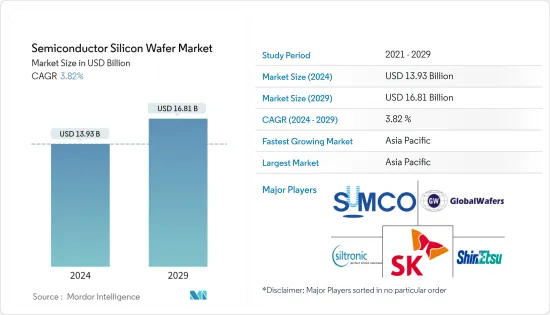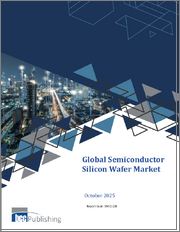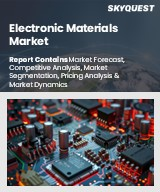
|
시장보고서
상품코드
1444429
반도체 실리콘 웨이퍼 : 시장 점유율 분석, 업계 동향과 통계, 성장 예측(2024-2029년)Semiconductor Silicon Wafer - Market Share Analysis, Industry Trends & Statistics, Growth Forecasts (2024 - 2029) |
||||||
반도체 실리콘 웨이퍼 시장 규모는 2024년에 139억 3,000만 달러로 추정되며, 2029년까지 168억 1,000만 달러에 달할 것으로 예측되고 있으며, 예측 기간(2024-2029년) 중 3.82%의 CAGR로 성장합니다.

주요 하이라이트
- 반도체 실리콘 웨이퍼는 여전히 많은 마이크로 전자 장비의 핵심 컴포넌트이며 전자 산업의 기초를 형성하고 있습니다. 디지털화와 전자 모빌리티가 기술 환경의 현재 추세로 인해 이러한 제품은 많은 장비에 적용되고 있습니다. 또한 소형 가젯에 대한 수요로 인해 단일 장비에서 더 많은 기능에 대한 요구가 증가하고 있습니다. 이는 더 많은 기능을 지원하기 위해 IC 칩에 더 많은 트랜지스터를 탑재해야 함을 의미합니다.
- 국제반도체장비재료협회(SEMI)에 따르면 COVID-19의 영향에 대한 불확실성이 커지면서 실리콘 웨이퍼 시장의 매출은 부진할 수 있다고 합니다. 그러나 칩 판매의 회복으로 수요는 증가세를 보이고 있습니다. SEMI는 또한 2022년 세계 실리콘 웨이퍼 출하량이 사상 최대치를 기록할 것으로 예상했습니다. 중국에서의 첫 COVID-19 발병은 중국공급망과 생산에 혼란을 일으켰습니다. 지난 20-30년 동안 중국이 세계 생산 기지가 되면서 주요 반도체 제조 산업은 큰 영향을 받았습니다.
- 반도체 산업은 전자, 자동차, 자동화 등 중요한 분야에서 중요한 혁신의 중요한 원동력이며, 반도체 기술은 모든 현대 기술의 컴포넌트로 부상하고 있습니다. 이 분야의 발전과 혁신은 모든 다운스트림 기술에 즉각적인 영향을 미치고 있습니다.
- 파운드리 업체들은 새로운 첨단 포장 기술, 특히 실리콘 웨이퍼 기반에 대한 투자를 늘리고 있습니다. 파운드리 업체들은 실리콘 대신 2차원 재료를 사용하여 모놀리식 3D 집적회로를 개발하는 채널로 사용하는 등 기술을 사용하여 트랜지스터 밀도를 향상시키기 위한 연구를 진행하고 있습니다. 예를 들어 TSMC의 칩-온-웨이퍼-온-서브스트레이트(Chip-on-Wafer-on-Substrate) 기술은 패키지 내에 8개의 HBM 메모리 장비와 결합된 두 개의 거대한 프로세서를 위한 공간을 갖춘 세계 최대 규모의 실리콘 인터포저를 개발했습니다.
- 웨어러블 기기의 발전은 시장 공급업체에게 큰 성장 기회를 가져다 줄 것입니다. 지멘스에 따르면 산업용 웨어러블은 가공 산업의 품질과 안전성을 향상시키기 때문에 거대한 시장이 될 수 있다고 합니다. Zebra Technologies Corporation에 따르면 2022년까지 전 세계 제조업체의 40-50%가 웨어러블을 채택할 것으로 예상됩니다. 또한 소형 가젯에 대한 수요가 증가함에 따라 단일 기기에서 더 많은 기능을 원하는 요구가 증가하고 있습니다. 이는 더 많은 기능을 지원하려면 IC 칩에 더 많은 트랜지스터를 탑재해야 한다는 것을 의미합니다.
- 중국과 같은 신흥 국가 전반에 걸친 정부의 우호적인 정책은 반도체 산업에 엄청난 기회를 제공하고, 예측 기간 중 반도체 실리콘 웨이퍼 시장이 확대될 것으로 예상됩니다. 예를 들어 중화인민공화국 국무원이 발표한 정책 프레임워크는 첨단 반도체 포장 솔루션을 반도체 산업 전반의 기술 우선순위로 삼는 것을 목표로 하고 있습니다.
반도체 실리콘 웨이퍼 시장 동향
가전제품 부문은 상당한 시장 점유율을 차지할 것으로 예상
- 현재의 시장 시나리오에서 노트북, 스마트폰, 컴퓨터 등 많은 전자제품은 여전히 실리콘 물질로 제조된 IC 및 기타 반도체 소자를 사용하고 있습니다. 가전제품 시장에서 실리콘은 여전히 주요 용도를 지배하고 있지만, 일부 용도에서는 새로운 재료가 이전 기판과 패키지를 대체하고 있습니다.
- Consumer Technology Association(CTA)의 "미국 소비자 기술 판매 및 예측" 조사에 따르면 CTA는 5G 지원 스마트폰 기기가 210만 대에 달하고 매출액이 19억 달러를 넘어 2021년까지 세 자릿수 증가율을 보일 것으로 예상했습니다. 애플은 2023년까지 미국 경제에 3,500억 달러의 기여를 약속하고 향후 5년간 240만 명의 고용을 약속했으며, 여기에는 신규 투자와 공급 및 제조를 위한 국내 기업에 대한 기존 지출이 포함됩니다. 이 회사는 가전제품 업계의 유명한 기업입니다. 따라서 이번 발표는 반도체 실리콘 웨이퍼 수요를 촉진할 것으로 기대됩니다.
- 최근 싱가포르 MIT의 연구기업인 싱가포르-MIT 연구기술연합(SMART)은 강력한 성능의 III-V 소자를 설계에 삽입한 통합 실리콘 III-V 칩을 제조하는 상업적으로 실행 가능한 방법을 성공적으로 개발했다고 발표했습니다.
- 현재 대부분의 장비에서 실리콘 기반 CMOS 칩은 주로 컴퓨팅에 사용되지만 통신 및 조명에 효율적이지 않기 때문에 효율이 낮고 열이 발생합니다. 따라서 현재 상용화된 5G 모바일 기기는 사용 중에 매우 뜨거워지고 얼마 지나지 않아 종료됩니다. 그러나 상업적으로 실행 가능한 방식으로 III-V족 반도체 소자와 실리콘을 결합하는 것은 반도체 산업이 직면한 가장 복잡한 과제 중 하나입니다.
북미가 큰 점유율을 차지할 것으로 예상
- 반도체 파운드리 및 웨이퍼 업체들에게 팹리스 반도체 기업이 주요 고객이기 때문에 북미는 2021년까지 시장 매출에 큰 기여를 할 것으로 예상됩니다. 팹리스 기업은 칩을 독점적으로 설계하고 제조 공장 없이 판매합니다.
- 이 지역의 주요 팹리스 기업으로는 AMD, Broadcom, Apple, Qualcomm, Marvell, NVIDIA, Xilinx 등이 있습니다. 북미는 첨단 반도체 시스템 설계 및 제조에서 중요한 역할을 해왔습니다. 이 지역에서는 반도체 웨이퍼 파운드리 설립 활동이 활발합니다. TSMC는 2021-2029년 총 120억 달러를 투자해 첨단 5nm 공정으로 칩을 생산하기 위한 12인치 웨이퍼 공장을 건설할 것이라고 발표했습니다. 또한 외국 기업에게 미국에 대한 투자와 일자리 창출을 촉구했던 도널드 트럼프가조 바이든에게 밀려난 이후에도 하이테크 공급망은 계속 변화할 것으로 보입니다.
- 이 지역의 전자 산업은 꾸준히 성장하고 있으며, 설계 및 팹리스 분야에서 활동하는 여러 기업이 상당한 점유율을 차지하고 있습니다. 미국 인구 조사국에 따르면 2019년 미국의 반도체 및 기타 전자 부품 산업 매출은 1,000억 8,000만 달러로 2023년까지 1,051억 6,000만 달러에 달할 것으로 예상됩니다. 스마트폰은 반도체 소비에 가장 큰 기여를 하는 것 중 하나입니다. 가전제품 분야에서. 최근 수년간 이 지역의 스마트폰 판매량은 지속적으로 증가하고 있습니다.
- 또한 미국은 세계 주요 자동차 기업의 본거지이며, 고성능 IC가 필요한 전기자동차 및 자동차의 자율주행 가능성에 투자하고 있습니다. 이는 반도체 실리콘 웨이퍼 시장 수요를 촉진하는 주요 요인 중 하나입니다.
반도체 실리콘 웨이퍼 산업 개요
반도체 실리콘 웨이퍼 시장은 경쟁이 매우 치열합니다. 시장 점유율 측면에서 소수의 기업 만이 현재 시장을 독점하고 있으므로 시장은 상당히 통합되어 있습니다. 그러나 기업의 미래 기술과 실행된 혁신이 반도체 실리콘 웨이퍼 시장이 크게 증가한 이유입니다. 시장에서는 기업이 지역적 입지를 확대하기 위해 여러 합병과 제휴가 이루어지고 있습니다.
- 2022년 3월 - SK실트론은 구미 국가공업단지 3단지에 위치한 300mm 웨이퍼 설비 증설을 위해 향후 3년간 1조5000억원을 투자하기로 결정했다고 밝혔습니다. 2022년 증설 공사를 시작해 2024년 양산을 시작할 예정입니다.
- 2022년 1월 - 세계 최고의 실리콘 웨이퍼 공급업체 중 하나인 GlobalWafers는 현지 공장에서 매월 약 20,000장의 고급 12인치 웨이퍼를 추가했습니다. 세계웨이퍼스는 이번 증설로 한국, 일본, 대만, 이탈리아 공장의 생산능력이 10-15% 증가할 것으로 예상하고 있습니다.
기타 혜택
- 엑셀 형식의 시장 예측(ME) 시트
- 3개월간의 애널리스트 지원
목차
제1장 서론
- 조사의 전제조건과 시장의 정의
- 조사 범위
제2장 주요 요약
제3장 조사 방법
제4장 시장 역학
- 시장 개요
- 업계의 밸류체인 분석
- 업계의 매력 - Porter's Five Forces 분석
- 공급 기업의 교섭력
- 소비자의 교섭력
- 신규 진출업체의 위협
- 대체품의 위협
- 경쟁 기업간 경쟁의 강도
- 시장 촉진요인
- 비전통적 최종사용자 업종으로부터의 수요 확대와 웨어러블 판매의 꾸준한 증가
- 시장이 해결해야 할 과제
- 고비용과 최종사용자 수요의 동적인 성질에 의해 생산자가 직면하는 운영상 과제
- 실리콘 웨이퍼의 비용에 관한 주요 고려사항
- 반도체 실리콘 웨이퍼 업계에 대한 COVID-19의 영향
제5장 시장 세분화
- 직경별
- 150mm 미만
- 200mm
- 300mm 이상(450mm 등)
- 제품별
- 로직
- 메모리
- 아날로그
- 기타 제품
- 용도별
- 가전
- 모바일·스마트폰
- 데스크톱, 노트북, 서버 PC
- 산업
- 통신
- 자동차
- 기타 용도
- 가전
- 지역별
- 북미
- 유럽
- 아시아태평양
제6장 경쟁 구도
- 기업 개요
- Shin-Etsu Handotai
- Siltronic AG
- SUMCO Corporation
- SK Siltron Co. Ltd
- Globalwafers Co.Ltd
- SOITEC SA
- Okmetic Inc.
- Wafer Works Corporation
- Episil-Precision Inc.
제7장 중국의 주요 벤더와 이해관계자의 분석
- Zing Semiconductor Corporation(Shanghai)
- MCL Electronic Material Limited
- GrinM Semiconductor Materials Limited
- Shanghai Simgui Technology Co. Limited
- Ferrotec(Hangzhou & Shenhe FTS)
- Zhonghuan Semiconductor Corporation
제8장 투자 분석
제9장 시장의 미래
KSA 24.03.18The Semiconductor Silicon Wafer Market size is estimated at USD 13.93 billion in 2024, and is expected to reach USD 16.81 billion by 2029, growing at a CAGR of 3.82% during the forecast period (2024-2029).

Key Highlights
- Semiconductor silicon wafer remains the core component of many microelectronic devices and forms the cornerstone of the electronics industry. With digitization and electronic mobility being the current trends in the technology landscape, these products are finding applications in many devices. Also, the demand for small-sized gadgets has increased the need for more functionalities from a single device. This means that an IC chip should now house more transistors to support more features.
- According to the Semiconductor Equipment and Materials International (SEMI), silicon wafer market sales could witness a dip amidst the looming uncertainty surrounding the impact of COVID-19. However, the demand climbed on the strength of rebounding chip sales. SEMI also estimates that silicon wafer shipments globally will reach a record high in 2022. The initial outbreak of COVID-19 in China disrupted the country's supply chain and production. Major semiconductor manufacturing industries have been significantly affected due to China becoming a world production center over the past two to three decades.
- The semiconductor industry has been a significant driver behind critical innovations in significant sectors like electronics, automobiles, and automation, with semiconductor technology emerging as the building block of all modern technologies. The advancements and innovations in this field are immediately impacting all downstream technologies.
- Foundries are increasingly investing in new advanced packaging techniques, especially silicon wafer-based. Foundry vendors are researching improving transistor density with techniques like utilizing two-dimensional materials instead of silicon as the channel to develop Monolithic 3D Integrated Circuits. For instance, TSMC's chip on wafer on Substrate technology developed the world's largest silicon interposer that featuring room for two massive processors combined with 8 HBM memory devices in a package.
- Advancements in wearable devices will create massive growth opportunities for market vendors. According to Siemens, industrial wearables could be a massive market as these devices enhance quality and safety in the processing industry. According to Zebra Technologies Corporation, 40-50% of manufacturers globally are expected to adopt wearables by 2022. Also, the demand for small-sized gadgets has raised the need for more functionalities from a single device. This indicates that an IC chip should now house more transistors to support more functionalities.
- Favorable government policies across emerging economies like China created enormous opportunities for the semiconductor industry, which is expected to expand the semiconductor silicon wafer market during the forecast period. For instance, the policy framework published by the State Council of the People's Republic of China aims to make advanced semiconductor packaging solutions a technology priority across the semiconductor industry.
Semiconductor Silicon Wafer Market Trends
The Consumer Electronics Segment is Expected to Occupy a Significant Market Share
- In the current market scenario, many electronic devices, including laptops, smartphones, computers, etc., still use ICs and other semiconductor devices manufactured from silicon substances. Although silicon is still dominating primary applications in the consumer electronics market, new materials have replaced the previous substrates and packaging for a few uses.
- According to the Consumer Technology Association's (CTA) 'US Consumer Technology Sales and Forecast' study, CTA expects that 5G-enabled smartphone devices will reach 2.1 million units and cross USD 1.9 billion in revenue with triple-digit increases through 2021. Apple announced a contribution of USD 350 billion to the US economy by 2023 and promised 2.4 million jobs over the next five years, which comprises new investments and its existing spending with domestic companies for supply and manufacturing. The company is a prominent player in the consumer electronics industry. Hence, the announcement is expected to propel the demand for semiconductor silicon wafers.
- Recently, the Singapore-MIT Alliance for Research and Technology (SMART), MIT's research enterprise in Singapore, announced the successful development of a commercially viable way to manufacture integrated silicon III-V chips with powerful performance III-V devices inserted into their design.
- In most devices nowadays, silicon-based CMOS chips are primarily used for computing, but they are not efficient for communications and illumination, resulting in low efficiency and heat generation. Thus, current 5G mobile devices on the market get very hot upon use and shut down after a short time. However, combining III-V semiconductor devices with silicon in a commercially viable way is one of the most complex challenges the semiconductor industry faces.
North America is Expected to Hold a Significant Share
- North America is expected to be a significant revenue contributor to the market by 2021, as fabless semiconductor companies are the prominent customers for semiconductor foundries and wafer players. Fabless companies make chip designs exclusively and market them without a fabrication plant.
- The major fabless companies in the region are AMD, Broadcom, Apple, Qualcomm, Marvell, NVIDIA, and Xilinx. North America has presented a crucial role in advanced semiconductor system design and manufacturing. The region has been witnessing increased activity in establishing semiconductor wafer foundries. TSMC announced that it would spend a total of USD 12 billion from 2021 to 2029 to build a 12-inch wafer plant to manufacture chips using the advanced 5 nm process. Moreover, tech supply chains will continue to shift even after Donald Trump, who pressed foreign companies to invest and create jobs in America, was defected by Joe Biden.
- The electronics industry in the region has been growing steadily and holds a prominent share in several enterprises operating in the design and fabless space. According to the US Census Bureau, the industry revenue of semiconductors and other electronic components in the United States during 2019 stood at USD 100.08 billion, and it is expected to reach USD 105.16 billion by 2023. Smartphones are among the most significant contributors to semiconductor consumption in the consumer electronics sector. In recent years, the region has witnessed consistent growth in smartphone sales.
- Moreover, the United States is home to some of the world's major automotive players, which are investing in electric vehicles and the self-driving potential of cars, which demand high-performance ICs. This is one of the major factors driving the demand for the semiconductor silicon wafers market.
Semiconductor Silicon Wafer Industry Overview
The Semiconductor Silicon Wafer Market is quite competitive. In terms of market share, only a few players dominate the current market, due to which the market is quite consolidated. However, players' upcoming technologies and the innovations carried out are the reason behind the significant boost in the semiconductor silicon wafers market. The market is even witnessing multiple mergers and partnerships so that the companies expand their geographical presence.
- March 2022 - SK Siltron Co. announced that it has decided to invest won 1.05 trillion over the next three years to expand its facilities for 300 mm wafers, which are located in Gumi National Industrial Complex 3. The company will begin the expansion work in 2022 to start mass production in 2024.
- January 2022 - GlobalWafers Co., one of the global leading silicon wafer suppliers, added around 20,000 advanced 12-inch wafers each month from local fabs. GlobalWafers estimates capacity to rise 10-15% at plants in South Korea, Japan, Taiwan, and Italy as a result of the expansions to satisfy strong demand.
Additional Benefits:
- The market estimate (ME) sheet in Excel format
- 3 months of analyst support
TABLE OF CONTENTS
1 INTRODUCTION
- 1.1 Study Assumptions and Market Definition
- 1.2 Scope of the Study
2 EXECUTIVE SUMMARY
3 RESEARCH METHODOLOGY
4 MARKET DYNAMICS
- 4.1 Market Overview
- 4.2 Industry Value Chain Analysis
- 4.3 Industry Attractiveness - Porter's Five Forces Analysis
- 4.3.1 Bargaining Power of Suppliers
- 4.3.2 Bargaining Power of Consumers
- 4.3.3 Threat of New Entrants
- 4.3.4 Threat of Substitute Products
- 4.3.5 Intensity of Competitive Rivalry
- 4.4 Market Drivers
- 4.4.1 Growing Demand from Non-Traditional End-User Verticals and Steady Rise in Wearable Sales
- 4.5 Market Challenges
- 4.5.1 Operational Challenges Faced by the Producers Owing to High Cost and Dynamic Nature of End-User Demand
- 4.6 Key Cost Considerations for Silicon Wafer
- 4.7 Impact of COVID-19 on the Semiconductor Silicon Wafer Industry
5 MARKET SEGMENTATION
- 5.1 By Diameter
- 5.1.1 Less than 150 mm
- 5.1.1.1 By Product (Logic, Memory, Analog, and Other Products)
- 5.1.1.2 Vendor Ranking Analysis
- 5.1.2 200 mm
- 5.1.3 300 mm and above (450mm, etc.)
- 5.1.1 Less than 150 mm
- 5.2 By Product
- 5.2.1 Logic
- 5.2.2 Memory
- 5.2.3 Analog
- 5.2.4 Other Products
- 5.3 By Application
- 5.3.1 Consumer Electronics
- 5.3.1.1 Mobile/Smartphones
- 5.3.1.2 Desktop, Notebook, and Server PCs
- 5.3.2 Industrial
- 5.3.3 Telecommunication
- 5.3.4 Automotive
- 5.3.5 Other Applications
- 5.3.1 Consumer Electronics
- 5.4 By Geography
- 5.4.1 North America
- 5.4.2 Europe
- 5.4.3 Asia Pacific
6 COMPETITIVE LANDSCAPE
- 6.1 Company Profiles
- 6.1.1 Shin-Etsu Handotai
- 6.1.2 Siltronic AG
- 6.1.3 SUMCO Corporation
- 6.1.4 SK Siltron Co. Ltd
- 6.1.5 Globalwafers Co.Ltd
- 6.1.6 SOITEC SA
- 6.1.7 Okmetic Inc.
- 6.1.8 Wafer Works Corporation
- 6.1.9 Episil-Precision Inc.
7 ANALYSIS OF KEY CHINESE VENDORS AND STAKEHOLDERS
- 7.1 Zing Semiconductor Corporation (Shanghai)
- 7.2 MCL Electronic Material Limited
- 7.3 GrinM Semiconductor Materials Limited
- 7.4 Shanghai Simgui Technology Co. Limited
- 7.5 Ferrotec (Hangzhou & Shenhe FTS)
- 7.6 Zhonghuan Semiconductor Corporation



















